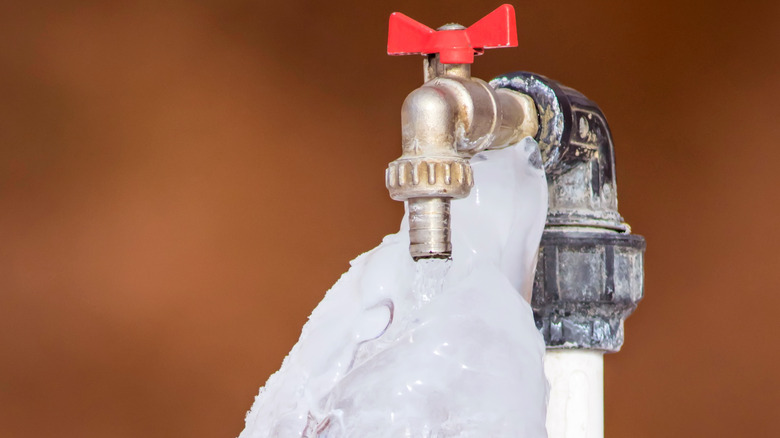Key Methods for Avoiding Frozen Pipes in Winter
Key Methods for Avoiding Frozen Pipes in Winter
Blog Article
Just how do you feel about Preventing and dealing with frozen pipes?

Cold weather can damage your pipes, particularly by freezing pipes. Right here's just how to prevent it from happening and what to do if it does.
Introduction
As temperatures decline, the threat of icy pipelines rises, possibly leading to costly repairs and water damage. Understanding how to prevent icy pipelines is critical for home owners in cool climates.
Comprehending Frozen Pipelines
What triggers pipes to ice up?
Pipelines freeze when exposed to temperature levels below 32 ° F (0 ° C) for extended durations. As water inside the pipes ices up, it broadens, putting pressure on the pipeline walls and possibly causing them to break.
Risks and problems
Frozen pipelines can lead to water system interruptions, residential property damage, and costly repairs. Burst pipelines can flood homes and cause considerable structural damage.
Indications of Frozen Piping
Identifying frozen pipes early can avoid them from breaking.
Exactly how to identify frozen pipelines
Try to find decreased water flow from taps, uncommon odors or noises from pipelines, and visible frost on exposed pipelines.
Prevention Tips
Insulating at risk pipelines
Wrap pipes in insulation sleeves or use heat tape to protect them from freezing temperatures. Concentrate on pipelines in unheated or outside areas of the home.
Home heating methods
Keep indoor rooms appropriately heated up, particularly locations with pipes. Open closet doors to allow cozy air to distribute around pipes under sinks.
Securing Outdoor Pipes
Garden pipes and exterior faucets
Detach and drain garden tubes before winter months. Install frost-proof spigots or cover exterior faucets with protected caps.
What to Do If Your Pipelines Freeze
Immediate actions to take
If you presume icy pipelines, keep faucets open up to alleviate pressure as the ice melts. Utilize a hairdryer or towels taken in warm water to thaw pipelines slowly.
Long-Term Solutions
Structural adjustments
Think about rerouting pipelines far from outside walls or unheated locations. Include extra insulation to attic rooms, cellars, and crawl spaces.
Updating insulation
Buy premium insulation for pipes, attics, and walls. Proper insulation helps maintain regular temperature levels and lowers the threat of frozen pipes.
Verdict
Stopping frozen pipes calls for positive measures and fast reactions. By understanding the reasons, indications, and safety nets, house owners can protect their pipes during winter.
5 Ways to Prevent Frozen Pipes
Drain Outdoor Faucets and Disconnect Hoses
First, close the shut-off valve that controls the flow of water in the pipe to your outdoor faucet. Then, head outside to disconnect and drain your hose and open the outdoor faucet to allow the water to completely drain out of the line. Turn off the faucet when done. Finally, head back to the shut-off valve and drain the remaining water inside the pipe into a bucket or container. Additionally, if you have a home irrigation system, you should consider hiring an expert to clear the system of water each year.
Insulate Pipes
One of the best and most cost-effective methods for preventing frozen water pipes is to wrap your pipes with insulation. This is especially important for areas in your home that aren’t exposed to heat, such as an attic. We suggest using foam sleeves, which can typically be found at your local hardware store.
Keep Heat Running at 65
Your pipes are located inside your walls, and the temperature there is much colder than the rest of the house. To prevent your pipes from freezing, The Insurance Information Institute suggests that you keep your home heated to at least 65 degrees, even when traveling. You may want to invest in smart devices that can keep an eye on the temperature in your home while you’re away.
Leave Water Dripping
Moving water — even a small trickle — can prevent ice from forming inside your pipes. When freezing temps are imminent, start a drip of water from all faucets that serve exposed pipes. Leaving a few faucets running will also help relieve pressure inside the pipes and help prevent a rupture if the water inside freezes.
Open Cupboard Doors
Warm your kitchen and bathroom pipes by opening cupboards and vanities. You should also leave your interior doors ajar to help warm air circulate evenly throughout your home.

I'm certainly very curious about How to prepare your home plumbing for winter weather and I hope you liked my article. Don't hesitate to pause to share this entry if you enjoyed reading it. Bless you for being here. Come back soon.
Information Report this page